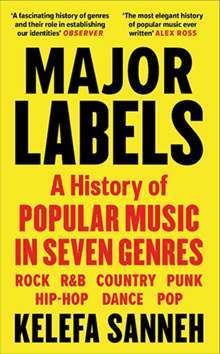 It’s not often I give up on a book, but Major Labels has defeated me.
It’s not often I give up on a book, but Major Labels has defeated me.
The subtitle “A history of popular music in seven genres – Rock R&B Country Punk Hip-Hop Dance Pop” should give you a clear idea of what the book is about.
The author covered rock and roll, hip-hop, and pop music for The New York Times from 2000-2008 and now writes for The New Yorker.
The first sections on Rock and R&B were engaging and, mostly, convincing. It’s territory that’s largely already well documented, although Sanneh does pluck out some lesser know facts and from them draws some interesting conclusions. Yes, there were notable omissions but you have to expect that in a single book covering so much. The main content runs to 550 pages with an index of 66 pages. So he can’t cover everything. I suppose that’s why the book doesn’t delve deeply into jazz, folk or other musical genres.
It was in the Country section that the anomalies and omissions started bothering me. How could Loretta Lynn be reduced to two short references and Tammy Wynette just one? When Sanneh talks about racism in country music, how is it that chart-topping Charley Pride is reduced to a single sentence, and a not very insightful one, at that. Surely, his story should be pivotal in understanding racism in country music.
There were, however, enough insights and background information to keep me interested. When Billboard invented the term Country & Western to hive off some of its listings into a specialty chart, the Country part referred to hillbilly music from the Appalachian mountains in the east, while the Western part referred to cowboy music from Texas and the southwest. Not identical types of music, but with enough in common to put them together. It wasn’t long before Billboard abbreviated this to just Country, as the form’s musical heart became fixed in Nashville. Which resulted in the oddity that a city in the heart of the south became identified with cowboy hats and boots, in an area where there’s no cattle ranching and, by definition, no cowboys. I’d never thought of it like that, and it’s an interesting point.
But it was in the Punk section he lost me, and I think I know why. In the earlier parts, Sanneh was dealing with history (including recent history) at a decent arm’s length. When writing about punk, however, things become very personal, dominated by the author’s own experiences as a punter, a player, a DJ and then a journalist and reviewer. This affects his coverage a great deal. It goes from being “a history” to being “a personal history”. Some might find this more engaging – I didn’t.
Punk is tricky to understand and analyse, let alone write about – which was part of the point of its emergence. It was (and is) anti-establishment music, especially the music establishment. It’s based on the belief that anyone can make music, it doesn’t have to be part of the big business that rock and roll, rock and pop had become. Sanneh correctly identifies that punk’s driving forces were a little more focused than that, driven by people like Malcolm MacLaren, who knew what he was doing in a quite deliberate, calculated way. The Sex Pistols did, after all, take their name from MacLaren’s SEX shop, which was also about selling the late Vivienne Westwood’s iconoclastic clothing designs. The Pistols were always a commercial enterprise, whether they liked it (or knew it) or not.
As to when and where punk emerged, and what is and isn’t punk, that’s not easy to pin down. Sanneh puts his personal spin on it, based mostly on concerts he attended and music he listened to. That’s neither comprehensive nor objective. Arbitrarily labelling bands proto-punk, pop-punk, punk-pop, post-punk, art-punk and punk-ish is unhelpful and becomes increasingly annoying. Focusing on extended personal reactions to Green Day while excluding any analysis of how punk broke Elvis Costello and Joe Jackson in the UK before everyone realised they were master musicians and singer-songwriters mystifies me (those two get no mention at all in the book, The Police get a tiny reference).
The trouble is that Sanneh uses his reflections to make a case for why musical genres themselves are no bad thing and how genre-hopping has produced some masterpieces. I don’t disagree with that, but when the “history” is so selective, how can we give any credence to his conclusions?
I said at the start that this book defeated me but, in truth, I think it defeated Sanneh.
Disappointing.